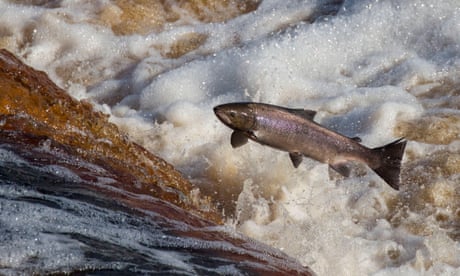
Europe removed a record number of dams and other barriers from its rivers in 2023, a report has found, helping to restore its disturbed waterways to their natural states.
Nearly 500 barriers were taken out of European rivers last year, according to figures compiled by Dam Removal Europe, an increase of 50% from the year before.
France led the way in helping rivers recover, with 156 removals, the report found, followed by Spain, Sweden and Denmark. The UK removed 36 barriers.
“It is amazing to witness another record-breaking year for dam removals in European rivers,” said Herman Wanningen, the director of the World Fish Migration Foundation and co-founder of Dam Removal Europe.
Europe’s rivers have been fragmented by dams, weirs, culverts and fords – many of which are no longer needed. An estimated 150,000 of the 1.2m barriers in European waterways are obsolete and possibly dangerous, according to the report, which documented 113 deaths involving river barriers in Europe since 2000.
Dam Removal Europe, a coalition of seven environmental groups including WWF and The Nature Conservancy, which aims to restore the free-flowing state of rivers and streams, said the pace of removals was rising.
It highlighted the removal of a quarry weir in Scotland, where a steep gorge blocked heavy machinery and meant the weir had to be removed by hand, along with the removal of a series of dams on the Hiitolanjoki River in Finland, where 34 miles (54km) of river has been opened up to salmon after being blocked for more than a century.
The EU’s proposed nature restoration law – the fate of which hangs in the balance after last-minute lobbying from member states – aims to reconnect 25,000km of fragmented river by 2030. But achieving this “will require a paradigm shift in river restoration”, according to a study in Nature that highlighted the “widespread impacts” caused by small barriers. Although large dams get the most attention, the researchers found that nine in 10 European river barriers are less than 5 metres high.
Connecting rivers helps wildlife travel and allows migratory fish to reach breeding grounds. Removing dams also allows water levels to vary over the year, which can cause habitat changes that increase the diversity of plants and animals, said Pol Huguet, a city councillor in the Spanish town of Manresa, whichremoved a dam as part of a rewilding project. He said: “Thanks to this change, for the first time, we have seen some fish going upstream to this part of the river.”
Dam removals are not always popular. When Poland removed its first big dam in 2021, most people in the area objected despite risks to their safety due to poor construction, a study found in February.
As carbon pollution heats the planet, allowing air to hold more moisture, the risks of extreme rainfall collapsing ageing river barriers is rising. At least three river barriers collapsed last year due to heavy rain in Norway, Northern Ireland, and Slovenia, the report found. Last week, a dam burst in the Orsk region of Russia as heavy rains flooded the area and forced more than 100,000 people across Russia and Kazakhstan to flee.
Obsolete barriers that were built to cope with different climates harmed the river and increased nature loss, said Wanningen. “It’s time to rethink the way we manage our rivers by removing all obsolete barriers and letting as many rivers as possible flow freely. A river that does not flow freely is slowly dying.”